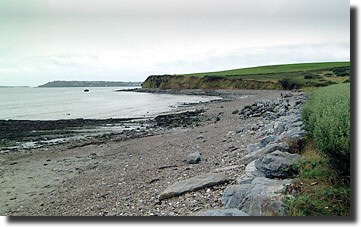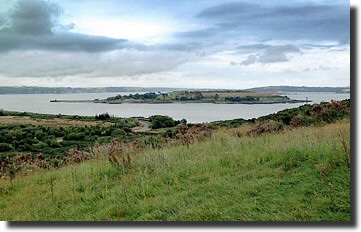|
A daring escape of three IRA volunteers from Spike Island detention centre
took place in April 1921. Spike had a long history as a place of detention. It had been used by Cromwellians and Williamites as a camp for convicts
awaiting deportation to the different convict settlements (e.g. the West Indies and later Australia). During the War of Independence
the British again chose Spike as an internment camp for republicans and their
sympathisers. The general conditions under which the men were confined
were extremely poor. In bad weather, the timber huts in which they were housed
would become impossible to live in. Moreover, the food was so bad that
the prisoners often refused to eat it. (Eventually a number of hunger strikes
broke out in protest at the conditions).
In the spring of 1921, Tomas Malone (alias Sean Forde), was one of the Spike prisoners, although the prison authorities were not aware that they
were detaining such a prominent Republican on the island. A fellow prisoner recognised Malone and let slip his identity to the
British. However,
the British were faced with a problem. They needed someone who could identify the IRA man with absolute certainty so they sent for someone who could pinpoint the Republican. This man was, however, executed by the IRA before he could ever set foot on the island. Meanwhile, Liam Lynch, aware of the situation, sent Malone a message that "we
will get you out of there. It will only be a matter of time before they identify you." Malone was notified shortly
afterwards that he was to be transferred to Cork together with a few other prisoners, and it was generally
feared that this could only mean that the men were going to be executed. Mick Burke, 0/C Cobh, was immediately told by Brigade HQ
in Cork to organise a plan of escape from the island, and together with Séan Hyde (0/C of the Ballinhassig Company) he set about hatching a plan. The three men to be rescued were
Tomas Malone, Sean MacSwiney (brother of Terence, martyred Lord mayor of Cork) and Sean Twomey and they were
notified of the plans.
At this time the Spike prisoners were engaged in building a golf course for the officers, near the shoreline. Normally only three prisoners at a time were allowed to take part in this work, under constant armed guard. The golf course sloped down to the sea at the north-east comer of the island and on the course, near the water, there was a small hollow where the prisoners took a break for a smoke. They were often joined there
by the guard, but on the Saturday morning of the planned escape the armed guard did not join the three prisoners but instead stayed up on the slope, visible from the barracks. Also keeping an eye on the three men on this day was a soldier, armed with a revolver, and a course supervisor. Meanwhile a motor launch had set out from Cobh with Captain Mick Burke, and
Volunteers George 0'Reilly, Andrew Butterley and Frank Barry aboard. Skipper of the boat was
"Duster" Walsh.

The
escaped volunteers landed on this beach near Ringaskiddy
village.
As a safeguard they flew the Union Jack from the launch but the good impression that the IRA men attempted to create was almost undone when they collided with a military launch carrying British soldiers between Spike and Cobh. Fortunately no serious damage was
caused and they were soon able to continue their journey. The boat moved in close to where the three prisoners were working, the IRA men aboard the boat pretending that they were just out fishing for the day. Some time passed before the prisoners went into action. Malone, half creeping and half running, made up the slope to the unsuspecting sentry and struck him a blow on the head with a hammer he had earlier been using while fixing a lawnmower. The sentry went down without a sound. The supervisor and soldier had already been overpowered, bound and gagged by Twomey and MacSwiney. The prisoners then raced down to the boat, bringing with them the sentry's rifle. However, barely had they pulled away from the island when some officers playing golf stumbled upon the gagged guards and upon seeing the launch, immediately realised what was afoot. The alarm was raised, one of the officers blowing a whistle and firing his revolver in the air. Meanwhile, the boat's engine had begun to give trouble and was losing power, so the men decided to head for Ringaskiddy only half a mile away. The boat was beached at a place called ‘Paddy’s Block’ and the seven
volunteers ran along below the Martello Tower and up the hill to Ringaskiddy
village, where transport would be waiting for them.

A
view from the Martello Tower below which the escapees
ran towards Ringaskiddy. Spike Island is in the background.
The trap could not accommodate
nine men, so it was decided that only the three escapees would travel with Hyde
and Crowley to Ballinhassig using by-roads to
get there. The horse raced through
Shanbally, hit the cornerstone and nearly turned over, then galloped hard down to Raffeen Bridge. They abandoned the
pony and trap here inside the ditch above the
bridge and took off on foot across country over Shannon Park on to Killingley Hill, and across to Mrs. Harris in Ballea where they had some tea. They
took off again and headed for Hyde’s
Knocklucy and they slept there for the
night before eventually reaching Ballinhassig. Mick Burke and
the other Cobh volunteers commandeered a boat and rowed to a
point between Raffeen and Monkstown. There Barry and O'Reilly crossed the River Lee to Rushbrooke, while Burke and Butterley took the train to Cork. News of the escape had travelled fast and the train was held up and the passengers searched at Glenbrook. Burke's and Butterley's accounts held up and they were allowed to proceed. Arriving in Cork, they reported the success of the operation at Miss Wallace's in St. Augustine Street, unofficial headquarters of the
First Brigade.

Séan
Hyde, Jerome Crowley and Frank Barry who were involved
in the dramatic escape from Spike Island.
All four volunteers made it safely back to Cobh. The skipper, "Duster" Walsh,
was arrested by the British, but having claimed the he took part in the action only
after a gun was put to his head, he was released shortly afterwards.
The three IRA groups involved in the escape had successfully combined forces to
rescue three high-profile republicans from an island fortress at a time when
British military strength in the Cork harbour was at its highest. The
launch used in the escape, the 'Raider', was later handed back to its owner,
Ned O'Regan, after the truce and Ned duly presented it to Mick Burke as a
souvenir of heroic times.
|



